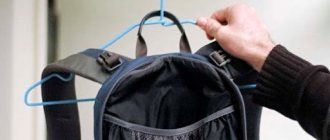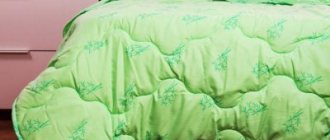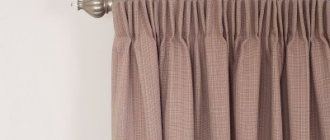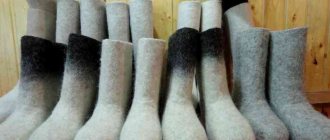Fjallraven Kanken backpacks are stylish and fashionable products that are convenient to go to school, college, work and sports training. It is not surprising that during such active use the product quickly gets dirty.
To keep your backpack clean, it must be cleaned and washed properly. Illiterate actions can cause damage to a branded bag.
In this article we will tell you whether and how to properly wash a Kanken backpack (Fjallraven Kanken) by hand and in an automatic washing machine.
How to wash a backpack in an automatic washing machine
Although most daypacks are machine washable, improper washing can ruin the seams.
And the portfolio itself will lose its original shape. To prevent this from happening, manufacturers indicate the appropriate temperature or washing mode on the label. Follow these guidelines. But if there is no tag, then here are some tips on how to wash your backpack in the washing machine.
Pre-soak in soapy water
To remove stains from your bag faster, you can soak the item in a weakly concentrated detergent before washing. Choose suitable powders and gels.
| Backpack material | What kind of detergent is suitable |
| Genuine Leather | Non-aggressive gel powders |
| Synthetics | Regular powders |
| Natural textiles | Grated soap or shower gel |
If among your household supplies there is no powder for your fabric and the color of your backpack, you can make a solution from available chemicals. For example, mix vinegar and baking soda. Leave the briefcase in this solution for a maximum of half an hour.
Which program should I choose?
“Hand wash” and “for delicate items” are perfect for cleaning backpacks. If there is a separate setting for cotton or synthetics, feel free to select it. Of course, depending on the material of your backpack.
Set the right temperature
On most machines you can probably select temperature values such as 60 or 90 degrees. However, you should know that only 60 degrees is suitable for synthetics. And 90 degrees is better left for coarse cotton.
For all other fabrics, 40 degrees is suitable. By the way, choose the same temperature for brightly colored products. Especially if the tag does not indicate what paint was used. If the temperature is too high, it can be washed out of the fabric and the backpack will lose its original appearance. Therefore, it is better to play it safe and wash at medium temperature.
Optimal number of revolutions
Many housewives forget about the correct settings for the number of revolutions and wash their briefcase at the standard setting. However, even durable canvas or nylon may not withstand more than 700 revolutions. The fabric is deformed when wrung out. Better choose 300-400 rpm. And if you have any doubts about the strength of the fabric, generally avoid spinning during the spin cycle.
Label
This label is printed on craft paper and feels indistinguishable from the paper sheets sold at craft stores.
The original label consists of three separate paper tags that differentiate the size and content. On one of the labels the information is presented in Vietnamese, on the other, decorated with a crown, in English.
The middle tag is larger than the others, the content depends on the store, some cover this tag with price tags. But there is a sticker with a barcode and information about the product printed in small print; peeling off the price tag a little, you can make sure there is text underneath it.
Ways to wash a backpack
Still, washing is a stressful situation for such a thing. Especially machine: regulate the number of turns and significantly soften its rotation in the drum, only partially possible - by choosing the gentle processing mode.
But, to be honest, from a hygiene point of view, such cleaning is of minimal benefit to a very dirty backpack. Except that it does not have any frame and is made in the form of a handbag with ribbons. Therefore, it is better to hand wash the product, specifically increasing the impact on especially dirty places.
Backpack in washable case
But when choosing any processing option, you first need to find out the following points:
Is it possible to wash the item at all? If the manufacturer allowed for such a possibility, then this must be indicated on the label inside the product.
Is the tag worn out or lost? Most likely, it will still be possible to fill the knowledge gap on the manufacturer’s website. Whether the darker areas of the item and the lining do not fade is important if there are light fragments of decor on the bag. It is enough to rub a damp sponge over the material, and then leave the cotton wool on the wet place for about 30 minutes to get a convincing answer to your question. In the same way, the loyalty of the selected washing substance to the composition of the paint on the backpack is determined.
Only the sponge is moistened not with water, but with its solution with the addition of powder or gel. Are there holes on the surface? If they are found, it is advisable to sew them up or process the edges so that the hole does not increase in size during the cleaning process. Are all decorative solid elements securely fixed in place? If one of them comes off during washing in the machine, then, provided the diameter is small, it can cause a blockage in the drain or a breakdown of the mechanism. Removable decor is removed during the process. Is there anything left in your pockets? A colored napkin or bright rag, a piece of lead pencil, or tobacco crumbs when wet can cause the appearance of new and difficult to remove stains on the light-colored material of the item. Do you store your laundry in the washing machine? Oh yes! No.
Chewing gum that sticks tightly is not a reason to wash it. By holding a cellophane bag with ice on the stain, after just a couple of minutes all traces of food rubber can be removed without any problems. There is no need to even put the product in the freezer, as some advisers write. Traces from a pen, especially if it has flowed and frozen on the backpack as a solid stain, are sometimes easier to dry and decorate with a sticker patch. Some pastes are washed off from fabrics very poorly, only after several treatments, which do not have the best effect on the color of the area with the affected material.
Before washing, it’s a good idea to think about how suitable the weather is for drying such a bulky item. After all, it is difficult to attach a backpack to a battery. And it is undesirable to do this - in order to avoid the appearance of unnecessary patterns or stains on the material due to exposure to elevated temperatures.
Expert opinion
Irina. Housewife.
Ask a Question
And in cold weather or high humidity, a backpack made of dense material that absorbs moisture well, such as tarpaulin, will take a long time to dry. And this can make the item smell musty.
Keeping it clean for long-term use
If you frequently machine wash your backpack, it may harm it. To avoid washing too often, there are a few precautions you should take:
- do not collect various rubbish inside, empty pockets, send everything unnecessary directly to the trash bin;
- do not place the bag on the ground, you can hang it;
- keep the inside clean (for example, in school backpacks, shoes and other items can be wrapped in a bag);
- Pens, felt-tip pens, drinks, and other liquids may cause stains that are difficult to remove, so you should take care of additional packaging;
- Wet wipes will help remove fresh stains and dirt.
By following these tips you can significantly increase the life of your backpack.
Where are these bags made?
Fjallraven Kanken is a Swedish company. But a real “urban suitcase” from this manufacturer will not be made in Europe. Any briefcase, bag or other item decorated with the popular Swedish logo will be sewn in Vietnam. It is in this Asian country that direct production, warehouses and packaging workshops are located. Only the company's brand stores and its head office are located in Sweden. Each item of the brand is in individual, tightly “soldered” packaging. And this feature makes it very difficult to determine what is presented in the store - an original or a fake.
What should you not pay attention to?
Fjallraven Kanken products are packaged in individual plastic bags, securely sealed. Of course, when purchasing an item, it is not always possible to inspect it. Some sellers will quickly refuse a purchase than allow the integrity of the package to be compromised.
But it is still impossible to determine whether it is an original or a copy based on the presence of individual packaging. This is due to the fact that EU countries have abandoned the use of plastic bags, disposable plastic tableware and similar items. Of course, the withdrawal from circulation is gradual and will take years.
Another packaging option for Fjallraven Kanken products is in development, and what it will be is unknown. For now, the bags are shipped to consumers without packaging. But in the store there may be a product that was sewn before the approval of the refusal of polyethylene and plastic as disposable materials. This bag will be packed accordingly.
Video: Fjällräven Kånken - how to distinguish an original from a fake?
Handwash
The entire backpack is not wet - it immediately becomes an order of magnitude heavier and it becomes more difficult to work. Rubbing the sides of the product against each other with your hands is also labor-intensive, so experienced housewives use a soft brush or even a sponge with one side that is hard. Having given preference to a brush, first check whether its lint leaves any snags or scratches on the material - so as not to end up with a clean item with a fairly worn facade.
Process details:
- Carefully separate the rigid frame from the bag, if present. If the wooden or cardboard seal cannot be removed, then clean the item without washing, with minimal exposure to water.
- If possible, knock out the backpack - the less dust and dirt remains in it, the easier it is to return the product to its original presentable appearance.
- For washing, use moderately warm water - not all materials survive elevated temperatures without changes.
- Be greedy with soap or powder - this simplifies the rinsing process and the item does not become covered with white streaks after drying.
- Degreasing gels are used more than carefully and precisely. Otherwise, excess water consumption during rinsing is guaranteed. Instead of such a gel, soap is used to remove stains, but without a whitening effect. To achieve the desired result, it is often enough to treat the area of contamination and wait about half an hour for the unwanted substances to leave the material.
Washing algorithm:
Moisturize and lather shiny areas. In case of severe contamination, after 30 minutes, soak the treated areas with a well-dampened, clean rag, and then repeat the initial execution. Using soda in a mixture with mustard will help out when there is a limited amount of water for rinsing and in the absence of soap from stains, including greasy ones. But provided that the fabric that needs processing is dark and not light in color. Use a wet brush, washcloth or piece of rag to walk throughout the backpack, moisturizing and applying the cleaning agent to the material of the product.
They look into secluded corners, paying attention to the joints where dirt likes to eat in especially strongly. It is not necessary to treat the entire thing - it is enough to periodically rub the soap on the brush or washcloth itself. Rinse several times, changing the water and, if possible, squeezing the product at least a little.
If twisting and squeezing it is impossible or undesirable, after each rinse, hang the backpack over a bathtub or deep basin to allow the water to escape. This significantly improves the results of each subsequent rinse. After putting the laundry out to dry, secure it more securely. In this case, the product is turned inside out, and all pockets are ensured in an open position, for example, by inserting plastic sticks.
Method #1: hand wash
If the problem of contamination is not too severe, sneakers and sneakers can be cleaned manually. For this you will need:
- a bowl of warm water;
- detergent - both powder and liquid are suitable;
- sponge or brush with soft bristles (you can use an old toothbrush).
You can do without machine washing - thanks to a proven basin and brush. The process itself is quite simple - dissolve the washing composition, achieve the appearance of thick foam and immerse the shoes in the basin for about 30 minutes.
Then arm yourself with a brush and begin to diligently scrub away the stains. When finished, rinse your sneakers with cool water and pat dry lightly with a towel. It is better to dry your shoes on the balcony or outside. You can lighten white sneakers and sneakers with a solution of lemon juice (1:4) or hydrogen peroxide. After rinsing, the shoes will look like new, and not a trace will remain of their former yellowness!
If your efforts have yielded a victorious result, and there are still dark marks on the light rubber sole, rub them with an ordinary office eraser. Using bleach is also possible: dissolve the powder in clean water and lay the sports pair so that only the sole is in contact with the detergent. After 1.5-2 hours, “walk” with a brush and proceed to rinsing.
Laces should be washed separately from shoes, exclusively by hand. The following improvised means will help remove yellowness and darkening:
- Ammonia and hydrogen peroxide: mix 15 ml of each component, dissolve in 1 liter of hot water and soak the laces for 30 minutes.
- Laundry soap: you just need to rub the dirty laces and leave for half an hour to an hour. Rinse thoroughly later.
- Toothpaste with a whitening effect: the principle of application is the same as in the case of soap. Leave to dry, wash and dry.
What to do with stains
Fresh stains from any fabric can be removed immediately with a damp sanitary napkin. Then you should wipe the affected area with a damp cloth. However, it is not always possible to do this right away. Therefore, the cleaning method depends on what the item is stained with:
a stain of grease on a school backpack or briefcase is common; it is recommended to sprinkle it with salt, baby powder or starch and press down lightly, and after an hour, brush off the grains and wash the entire thing or wash the affected area if it is not possible to wash the whole thing;
An anti-grease gel designed for cleaning stoves and ovens will also help remove grease; ink and paste from ballpoint pens can be removed with alcohol, but you can only rub products made of leather or faux leather, having first made sure that the alcohol will not damage the material; in other cases, apply a cotton wool soaked in alcohol to the stain, then carefully remove it, running along it from the edges to the center , repeat the procedure several times; many stains can be removed by laundry soap; you need to soap the affected area and leave for a couple of hours, and then rinse with warm water; Chewing gum is afraid of frost; you can easily remove it by putting your backpack in the freezer of the refrigerator for several hours, and then simply remove the gum.
How to wash a backpack: step-by-step description
Before washing the backpack, you should do the following:
- Study the label and determine how to wash the backpack.
- Clean the outside with a soft brush. This way there will be less dust and when wet it will not get into the fibers.
- Clear all pockets and compartments of foreign objects.
- Check the pattern and color of the fabric for strength. To do this, rub them with a piece of rag soaked in warm water. If the paint comes off, the product cannot be machine washed.
The temperature for any cleaning method should not exceed 30 degrees. It is better to choose a liquid product, taking into account the fabric and the manufacturer’s recommendations.
Simple soap shavings are also suitable for a school backpack, and for more expensive membrane models, the industry produces special substances (for example, Nikwax, Salton Sport, Domol) that wash and at the same time nourish the material, improving its properties.
Among the powders, positive recommendations include:
- Villi;
- Cashmere;
- Tide;
- Weasel;
- Sarma.
The following brands are popular among gels:
- Flat;
- Help;
- Dreft;
- Meine Liebe.
Please note that to extend the life of your favorite accessory, it is better to choose a liquid detergent. It does not leave streaks on the surface and is washed out better when rinsed.
In a washing machine
Before immersing the item in the drum, complete all the previously prescribed preparatory steps and note that:
- Ideally, the frame should be removed if provided by the manufacturer, which allows automatic washing. Typically, models with a non-removable top layer should be washed by hand.
- After this, it is best to turn the product inside out. This action will help get rid of small debris.
- All removable elements must be unfastened and the straps placed inside. For clothing, machine manufacturers recommend closing the zippers. But this is not suitable for a backpack, because it will not be able to completely wash the inside.
- The finished item must be placed in a special bag or pillowcase.
- Set to “Delicate”, gentle wash.
- Don’t forget to press the “No spin or dry” button.
- Pour the required amount of gel into the appropriate compartment of the washing machine. Usually 1-2 caps are enough.
- It is possible that an extra rinse will be needed. It will protect you from white soap stains on the fabric.
How to wash by hand
This option is best suited for school models. To wash a briefcase in this way, you need to spend very little time. In addition, it is considered the most gentle and least traumatic for the material and its coloring pigment.
- Hand washing is best done with laundry soap or tar. It should be grated and dissolved in water.
- The temperature of the liquid should not exceed 40 degrees.
- The backpack must first be soaked for 30 minutes.
- Heavily contaminated areas can be rubbed with a soft brush, and a thick sponge can be walked over the surface itself.
- Rinse the product thoroughly (preferably with a running stream). The action should be repeated many times so that there are no streaks after drying.
- You can’t wring out the backpack; it’s better to let it drain on its own.
When washing by hand, straps and straps require special care, because they actively absorb sweat and dirt, as they are in close contact with the body. In addition to the fact that they need to be unfastened before washing, they should be cared for a little differently:
- Pour warm (40 degrees) water into the container.
- Dissolve 1/4 cup of dishwashing detergent in it.
- Whip into thick foam.
- Apply it to belts and straps.
- Rub with a clothes brush.
- If necessary, immerse in the resulting solution, but do not keep for more than 15 minutes.
- Rinse under running water.
- Hang on a line to drain and dry.
Expert advice
Sometimes a strong-looking backpack can be ruined during normal washing, which our wardrobe items can easily, if not “happily,” endure. What are the pitfalls in this useful process?
For cleaning a leather backpack
- It cannot be washed. And do not wet the inner surface of the skin too much, otherwise it will begin to shrink, become rough and lose its attractive appearance. They just wipe it if there is such a strong need for hygienic treatment. Some wet wipes are best suited for this.
- A soft material should not be rubbed with a rough brush.
- Do not use caustic alkalis - a soap solution is often sufficient.
A leather backpack
For cleaning a leatherette backpack
- Can't be washed. Only wet processing is possible.
- She is even more “afraid” of hard brushes and aggressive substances than bags made of genuine leather.
- After wet wiping, immediately pass over the surface with a dry rag: this does not allow excess moisture to penetrate into the material at the places of punctures from the needle and affect the uniformity of coloring of the product.
For cleaning a polyester backpack
- They can even be washed in a machine, if it is not treated with a water-repellent agent and does not have prints applied with paint - the coating cracks and the decoration loses its decorative purpose.
- The temperature is set no higher than 40 degrees. It’s better to go lower so that the color of the item doesn’t fade.
- Be sure to do a test for the presence of shedding areas and do not wash together with items of a different color or with terry inclusions.
Polyester backpack
Combined method
Associated with water and fire, it also gives a bright shine to the ankle boots, but eliminates the dangerous operation of setting the cream on fire, and includes the following stages:
- the cream is applied to the surface in a thick layer using a damp cloth or cotton swab;
- then the surface is heated with fire from a lighter or heated with a hairdryer;
- wipe with a damp cloth and dry;
- then the operation with the distribution of the creamy mass and heating is repeated;
- After applying at least five layers, you can proceed to final polishing.
When applying cream with a damp cloth, more of it gets onto the surface. Water creates a barrier that prevents it from smearing on the material. Warming up ensures better spreading of the mass and its penetration into cracks and scratches. Of course, getting shiny boots is a rather labor-intensive process, requiring up to 15 layers and several polishings. But the result is not only about beauty. Repeated treatment protects shoes from moisture and dirt, reduces leather wear. And it also really calms the nerves.
Source
How to clean shoes from dirt inside?
If cleaning shoes from the outside does not cause any particular difficulties, then putting them in order from the inside can be difficult. Use the following tips and tricks to clean the inside of your shoes:
- Use an old toothbrush (preferably one with stiff bristles) and a mild solution of laundry detergent to scrub away the dirt from the inside. Rub the insoles carefully and carefully, the main thing is not to be too zealous.
- Regularly (once a week) wipe the inner surface of the shoes with a solution of ammonia (1 teaspoon of alcohol per 1 liter of water). This procedure will not only save the appearance of the shoes, but also relieve them of the unpleasant odor.
- To clean insoles made of thin leather, use baby cream. First, use a slightly damp rag or sponge to remove dust and heavy dirt from the inside of the shoes, and then apply a thin layer of regular baby cream and rub thoroughly into the dirty areas. Wipe off any remaining cream with a dry cloth and leave the shoes to dry. The inner surface of the shoes will become not only clean, but also soft.
- To clean the textile interior of boots, use regular shaving cream. Shoe makers recommend using shaving foam for this purpose: carefully apply the product inside the shoes, and after 30 minutes, remove the dirty foam with a cloth.
- To clean the dirt inside your shoes, if the dirt is persistent, try carpet cleaners. After treating leather insoles with this product, be sure to soften the inner surface with baby cream.
- Use a special foam for leather and suede to clean the inside of your shoes. The product perfectly cleans the insoles.
Dry cleaning
You can remove dust from your backpack using a vacuum cleaner.
Guide to action:
- remove all things from the backpack and its pockets - they can get into the hose and clog it;
- Plug in the vacuum cleaner and put on the wide nozzle;
- walk over the surface of the product with a brush, do not press it hard against the fabric;
- Vacuum the product from the inside by removing the nozzle.
If there are greasy stains on things, you can sprinkle them with starch or talcum powder before cleaning, lightly pressing the powder with your palm. After 2 hours, the fabric is vacuumed.
You can get rid of a single stain with a damp cloth. Use it to gently wipe away dirt without applying significant effort.
Hand wash
For many reasons, it is not recommended to wash things in a washing machine, and even more so, this cannot be done if your backpack is large. You can wash such a voluminous item in a large basin or right in the bathroom. How to do it?
- Preparing the product for washing is the same as when washing in a washing machine, except that the backpack does not need to be turned inside out and does not need to be placed in a special bag or pillowcase.
- The water should cover the item completely.
- If you are going to wash with powder detergents, do not pour it directly onto the backpack. First, the detergent composition is diluted, it is better to choose a liquid gel, in water with a temperature of 30 - 40 ° C, then the product is dipped into it.
- Any stains must be removed in advance. Uncleaned persistent stains may not only not be washed off after washing, but will become even more firmly attached to the material.
- Do not try to wring or twist your backpack too much. Some of its parts may not hold up. To treat heavily soiled areas, use a soft brush or washcloth and regular laundry soap. Use an old toothbrush to reach hard-to-reach areas.
IMPORTANT! There are different brands of washing soap available on the market. Using white soap with a bleaching effect on black or brightly colored fabric may cause discoloration and the appearance of faded whitish spots on the material.
- After washing, rinse the item thoroughly under warm, clean water.
- Do not twist the backpack too much; it is better to hang it straightened out over the bathtub and let the water drain on its own.
- If the backpack or satchel had a waterproof coating, it can be restored after washing, when the item is completely dry, by treating it with a purchased water-repellent compound.
- Make sure that the backpack is completely dry, as storing it in a damp closet can cause mold to grow.
It is not recommended to wash such items regularly, especially in a washing machine. Due to frequent mechanical processing and the use of harsh, aggressive detergents, the material can significantly change its original color, fragile seams can come apart, and fabric worn in some places can tear even more.
If your backpack is quite expensive or you simply don’t trust yourself and the washing machine, take it to the dry cleaner.
Fjallraven Kanken
The popular Fjallraven Kanken backpacks today do not need advertising - the Fjallraven company has become famous all over the world solely thanks to them. Now the Kanken briefcase is the most recognizable model on the streets all over the world, and it recently celebrated its 40th anniversary. The design of the backpack is very original and laconic, thanks to which the model has a large number of fans.
The history of the Kanken backpack began in the 1970s, when Fjallraven founder Åke Nordin decided to create a backpack that was convenient and affordable for students. In those days, schoolchildren wore a lot of things to class, which had a detrimental effect on the health of their backs. The Kanken backpack evenly distributed the load, which reduced the risk of spinal curvature.
When designing the backpack, which became the Kanken model, Nordin took into account such parameters as the dimensions of the largest A4 notebooks
And in order to take into account the wishes of the students themselves, he turned to the Association of Guides and Scouts for advice. At the beginning of 1978, the world saw the first batch of Kanken backpacks in the amount of 200 pieces and was sold out almost instantly
The company hastily produced another 200 pieces.
The very next year, the Fjallraven company experienced incredible success - the backpack model was sold in the amount of 30 thousand pieces, and every year the figure increased in phenomenal progression. By 2008, about 2 million different models of the Kanken backpack were sold all over the world, and at least 200 thousand pieces are produced annually.
The secret of the success of the Kanken backpack is that it appealed not only to schoolchildren, but also to many adults. To this day, it is widely used in sports and for city walks - it looks very stylish, moreover, it can easily accommodate all the things a modern city dweller needs - documents, thermos, lunchbox, everyday purchases. A big bonus is that the Kanken backpack is lightweight and looks very simple.
Machine washable
Here it is important to preserve the item, clean it, and save the washing machine. Due to the compactness of the product, the unit is not able to control the impact on the drum using the layout of the bag, as happens, for example, with linen and other things
Therefore, the active mode can only be used for soft backpacks that resemble bags for carrying shifts. For other models, settings for hand or gentle washing are suitable, but without using the spin function at all.
Washing algorithm:
- remove the frame;
- pre-treat the most heavily soiled areas using stain-reducing soap or a product on hand;
- turn the item inside out - this avoids scratches on the drum from bulky fittings and hard decorative elements on the bag;
- Having loaded the backpack, turn on the machine and pour a little washing gel, powder or a self-prepared solution of water and laundry soap into the cuvette;
- after waiting for the end of the active washing period, turn off the unit;
- After opening the door, take out the backpack and rinse it in the same way as if you were washing the product by hand.
Wet cleaning the backpack
Lining
The original lining has one difference from the vast majority of fakes. It contains a special liner made of vinyl. As a rule, it is not counterfeited, since the presence of this liner increases the cost of the bag.
Insert - in a compartment intended for a laptop or other things that require separate placement. You can take it out, sit on it on the steps and put it back. Of course, the insert also provides protection for the laptop and acts as a frame.
Rules of care
In order to avoid the appearance of stench from your favorite rug, you must follow the recommendations for caring for it:
- Vacuum your new carpet immediately after purchase. After production, loose fibers remain in it, as well as dust from a store or factory;
- A new, smelling carpet should be well ventilated in the fresh air, following the manufacturer's recommendations. It is strictly forbidden to place the product in direct sunlight. If it is not possible to take the carpet outside, then it is worth ventilating the room in which it is located more often;
- Immediately blot up any liquid that gets on the carpet. To do this, you can use paper towels or a vacuum cleaner with water suction function. Large wet spots can be dried with a hairdryer with cold air function;
- do not put the carpet away for long-term storage without first removing stains and odors, or in a damp state;
- Do not place the product, especially those made of synthetic fibers, in direct sunlight. When heated, the fibers can melt and cause an unpleasant odor that cannot be removed;
- When putting the carpet away for storage, you need to roll it up and lay out the layers with paper. The product should be unpacked and ventilated at least once every six months;
- Avoid getting food or other organic matter on the carpet. In areas where animals are fed or where small children are constantly present, the carpet must be protected with a waterproof covering;
- do not spread the carpet on a wet floor without waiting for it to dry completely after cleaning;
- do not use products with pile in rooms with high humidity;
- carry out preventive cleaning of the carpet using industrial means or a traditional method at least once every few months;
- in winter, take the carpet out into the snow or take it to the dry cleaner once a year;
- Clean the carpet not only from the front side, but also from the back side. This rule applies not only to thorough cleaning with detergents, but also to the use of a vacuum cleaner;
- strictly follow the manufacturer's recommendations for caring for the product. Do not use strong-smelling chemical compounds in concentrated form to remove stains.
When choosing care products, you need to pay attention not only to the origin of the contamination, but also to the material of the product. In this way, it will be possible to achieve high-quality and safe results.
Drying Features
You need to dry your backpack correctly. General recommendations to follow:
- Do not wring items made from delicate fabrics or with a rigid frame. If the bag is completely fabric, then wrap it in a terry towel and gently press it so that it absorbs excess water.
- Do not expose the fabric to direct sunlight.
- The product should not be hung on heating devices or near heat sources.
- Depending on weather conditions, the backpack is dried either in a heated room with a normal level of humidity, or on the balcony.
- The product should not be hung, as unsightly creases may appear on it. It is better to place the backpack on a flat surface, having first spread a terry towel or other fabric on it.
The accessory should not be put away for storage immediately after drying. It is kept in the open air for several days. If you wrap the product in plastic or put it in a closet, unevaporated moisture can rot, leading to mold and an unpleasant odor.
How to wash mattress covers made of different materials
Covers with different fillings have their own characteristics and corresponding care rules.
Wool
These mattress covers require regular care, and it is recommended to avoid frequent washing. They can be washed by hand or in an automatic machine, setting the “delicate” mode, “wool” / “hand wash”.
It is prohibited to wring out the product, as well as dry it in a machine. Use special mild detergents designed for woolen items. The composition must contain lanolin.
The mattress cover does not need to be unscrewed. Simply place it in the bathtub to allow the water to drain completely. Next, the cover is dried unfolded on a horizontal surface.
Downfeathers
A cover with feather filling can be washed in an automatic machine, provided that this is provided for by its loading standards. It is not possible to wash a bulky item in an automatic machine if its loading parameters are less than 7 kg. Even if you manage to place the cover in the drum of the machine, the washing will not be of high quality.
For automatic washing, a delicate cycle with medium speed and a maximum number of rinses is recommended. All standard detergents are prohibited. Use only capsules or gels.
The feather mattress cover can be rinsed in water with the addition of white vinegar at the rate of 1/3 cup of 9 percent vinegar per 10 liters of water.
Latex
Thick latex covers, as well as products made of polyurethane foam and memory foam cannot be washed. Otherwise, the filler will completely lose its properties, and the case will become unusable. The manufacturer recommends only a dry method for cleaning latex covers.
Polyester fibers
These artificial materials are traditionally used as insulation in the sewing of outerwear, in the production of blankets, pillows and mattress covers. Excellent resistance to washing and spinning in various modes.
It is recommended to wash such products with liquid gel, which is quickly washed out of bulky bedding, unlike standard powders.
Cotton fiber
Washing in hot water may cause fabric to shrink. Therefore, we do not use water with a temperature exceeding 40 degrees
We carefully distribute the crumpled filler by hand as carefully and carefully as possible. Iron with a warm iron
We wash children's cotton mattress covers with products intended for washing children's clothes.
Bamboo fiber
Washing in an automatic machine at a temperature of less than 40 degrees is allowed. Do not use aggressive detergents. Spin at minimum speed. Ironing is prohibited.
Coconut fiber
The coconut coir filling, which is the inner layer of the cover, cannot be washed by machine. Hand washing is also prohibited. Dry cleaning of the upper fabric part is recommended.
Antibacterial
Products with antibacterial properties are washed according to the recommendations on the tag. Typically, the impregnation itself can withstand up to hundreds of washing cycles in any way without losing its properties.
Fasteners, zippers, snaps and buttons
copies are several times cheaper than original bags and backpacks, so low-quality accessories are used in their production. But K anken backpack may have branded fasteners, zippers and buttons, so this cannot be considered a reliable sign.
Main features of branded fittings:
- recognize original Kanken bags and backpacks by their branded YKK fittings, decorated with the embossed emblem of the manufacturer (fox) on the zipper pulley.
- The original's fittings are made of brass; the zipper always matches the color scheme of the material used. If the zipper is not decorated with a brand logo, this is a fake product.
- To check the originality of the accessories, touch the lock or zipper with the inside of your wrist. Real brass fittings do not heat up under the influence of temperature, but fake ones most often heat up quickly.
- On real backpacks, the sliders are only black; on replicas you can see multi-colored sliders.
Important! Brass fittings have several other differences from cheap counterfeits. The brass zipper pull is decorated with a fox on one side and the inscription Fjallraven on the other. The buttons are also decorated with a fox logo and the words WASA 6.











